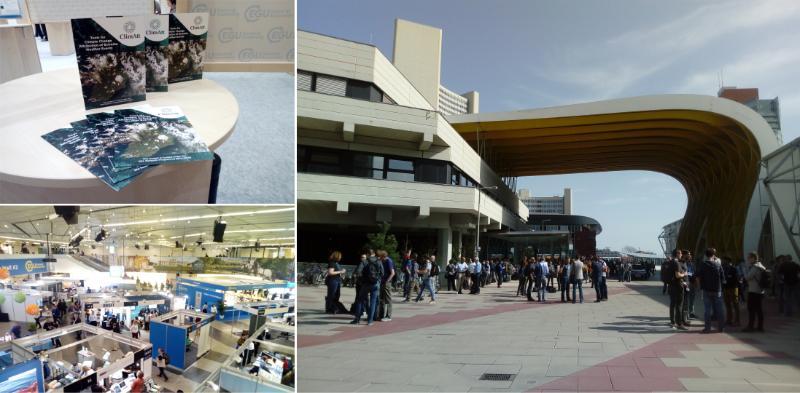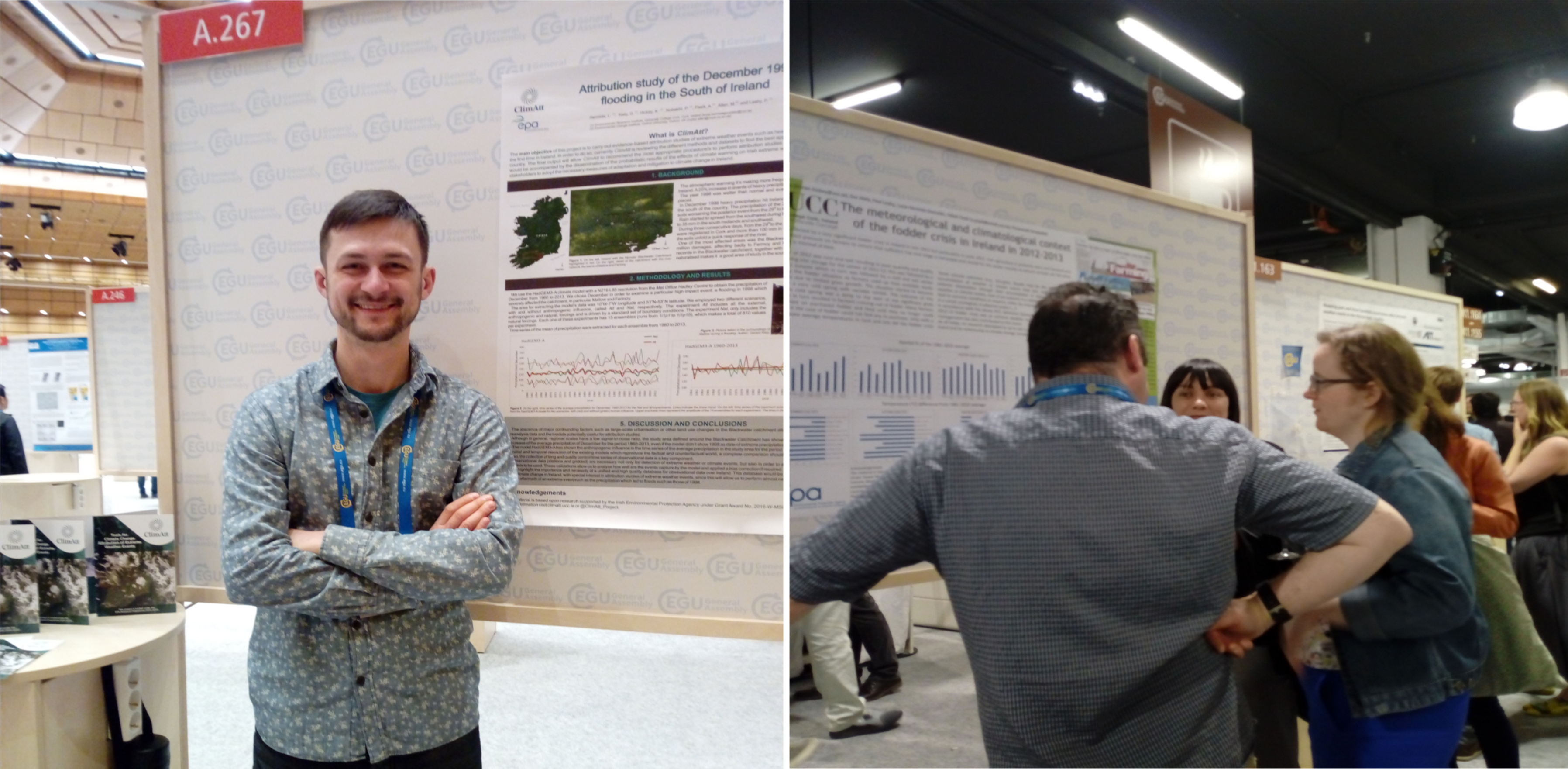In This Section
European Geoscience Union 2018

During the week 9th – 13th of April 2018, ClimAtt was at the European Geoscience Union (EGU) at the Austria Center Vienna.
The ClimAtt team presented three posters at the conference in the sessions:
- Extreme meteorological and hydrological events induced by severe weather and climate change
- Detecting and attributing climate change: trends, extreme events, and impacts, and
- Hydroclimatic extremes under change: advancing the science and implementation in hazard prevention and control.
Lucia Hermida, Gerard Kiely, Kieran Hickey, Myles Allen and Paul Leahy
The warming of the climate system due to anthropogenic climate change not only leads to slow changing events such as the increase in the mean sea surface temperature (SST), but is also expected to cause changes in the magnitude and/or frequency of extreme weather extreme events, e.g. precipitation, floods, heatwaves. Many of these changes have, to some extent, been attributed to human influence in terms of probabilities.
Different studies have analysed the variations in indices of extreme temperature and precipitation between historical and simulated future datasets under different IPCC carbon emission scenarios. However, to the best of our knowledge, no previous study has investigated possible changes of such indices in Ireland between the actual world (factual) and the counterfactual world (i.e. a world without the anthropogenic human influence).
Extreme precipitation indices were obtained from daily observational time series of precipitation provided by Met Éireann, the Irish Meteorological Service. Sources such as GPCC, GHCNDEX or HadGHCND were also considered. The RClimDex package, from the Expert Team on Climate Change Detection and Indices (ETCCDI), was used to verify the quality and homogeneity of the time series and the calculation of extreme indices related to precipitation.
The evaluation of the performance of the different datasets for the extreme precipitation indices over Ireland resulted in the selection of a cluster of best-suited data for attribution studies of extreme weather events with the biggest impacts on Ireland, namely long duration precipitation (typically greater than 24 hours) and associated flooding.
Extreme indices of precipitation were then used to validate outputs of climate models such as HadGEM3 for the actual world. Indices for the counterfactual world are also obtained using the climate models. Finally, changes in extreme precipitation between the two scenarios were studied.
The results will be further used for an attribution study from a dynamic point of view, analysing the changes in the synoptic patterns associated with those extreme indices of precipitation between both worlds.

Figure 2. On the left, Adam Pasik, master student of the ClimAtt project, during the poster session. On the right, Dr. Kieran Hickey answering some questions about the Fodder Crisis at the EGU.
Attribution study of the December 1998 flooding in the South of Ireland
Lucia Hermida, Gerard Kiely, Kieran Hickey, Parvaneh Nobakht, Adam Pasik, Myles Allen and Paul Leahy
Increases in annual precipitation and in the occurrence of extreme precipitation events have already been detected in Ireland since the middle of the 20th century. The changes in precipitation are primarily associated with the number of rain days, rather than the amount of rain. Many parts of Ireland are vulnerable to pluvial floods predominantly caused by longer periods (greater than 24 hours) of low intensity (less than 5mm/hour) precipitation. However, antecedent weather and environmental conditions influence the magnitude of the flooding.
The Munster Blackwater Catchment, in the south of Ireland, is one of the least modified major catchments in the country, with a low level of urbanisation. The catchment has an area of approximately 3324 km2.
The year 1998 is selected as a study case for being wetter than normal and the wettest for 30 years in some places. On the 29th December over 30 mm were registered in southern areas. On the 30th and 31st another depression affected the catchment area. During these three consecutive days of rainfall, more than 50 mm were recorded at Cork. Mount Russell registered the highest daily rainfall value of December on the 29th with a total of 35 mm.
The heavy rainfall between the 29th and the 31st of December 1998 led to a major flood on the Munster Blackwater, with a peak flow occurring on the 29th (the highest of the year and the fourth-highest since 1977). The rainfall caused a quick response of the river level due to the near-saturation of the soils in the catchment, with the river overtopping its banks on the 30th and lasting more than 48 hours. More than 5 IR£ million (c. €.35 million) damage was caused to property.
The historical precipitation record for the Blackwater catchment was analysed with observations data provided by two government agencies, Met Éireann and the Office of Public Works (OPW). Both datasets were subjected to a process of quality control (QC) and homogenization when required. The results of the QC exercise led to the selection of a database of suitable stations and a historical period with a sufficient number stations of long records to contextualize the event and validate models.
Models comprising two different experiments were examined: one, which represents the world as we know it today (factual), and other with the world as it would have been without anthropogenic climate change (counterfactual). The probabilities of events similar to that which led to the 1998 floods in both scenarios were calculated. The values were used to determine if this kind of event is more likely to happen due to climate change through the calculation of the risk ratio (RR).
The meteorological and climatological context of the fodder crises in Ireland in2012-2013
Kieran Hickey, Paul Leahy, Gerard Kiely, Myles Allen, Adam Pasik and Lucía Hermida
Ireland was affected by a very significant fodder crises in Ireland in late 2012 but particularly in early 2013.
Irish agriculture is primarily based on grass production for dairy and livestock. There is constant pressure on farmers to ensure that sufficient hay and silage is harvested and stored for the winter months to ensure animals are fed when grass growth is minimal at best.
The summer of 2012 saw below-average temperatures and sunshine hours and higher than average rainfall in June and July resulting in poor quantity and quality of fodder going into storage for the winter of 2012-13. This was followed by a cool and dry autumn which in turn was followed by a cold and wet winter exacerbating the fodder situation as farmers used up their available stocks quite quickly due to limited grass growth. The situation started to become critical with a very cold spring with mean seasonal temperatures up to 1.8oC below the long-term average and variable rainfall. The outcome of this exceptionally cold spring was a delay to the start of any significant grass growth. This in turn resulted in farmers running out of fodder. Many farmers become reliant on purchased fodder and feed until they no longer could afford it or in the case of fodder they could not find any to purchase. Only with a return to above average temperatures in June and July did the fodder crises abate.
The fodder crises is estimated to have cost Irish agriculture at least 500 million euro. This cost was made up of additional expenditure on feed and fodder including the import of fodder from France, a reduction in milk production, early slaughtering of cattle due to lack of feed and approximately 23,000 livestock deaths. This paper will analyse the meteorological contribution to the fodder crisis of 2012-2013 and will provide an initial assessment of this complex event in the context of recent climate change and attribution.
It was a long but great week where we had good chats, made interesting contacts and leave the door open to new promising collaborations. We will keep this thread updated if there are further developments!
ClimATT
Climate Change Attribution of Extreme Weather Events
Contact us
